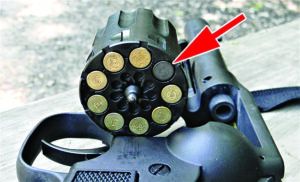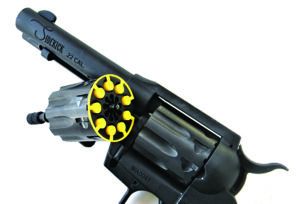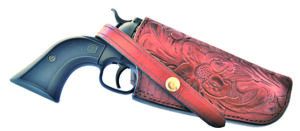Most handgunners own a rimfire revolver or two and appreciate them as affordable and enjoyable plinkers, useful for informal target practice, firing at tin cans, dirt clods, and other stuff on a range backstop (where allowed). Such revolvers allow for cheap and easy marksmanship training, and because of their manual of arms, they make it clear to a new shooter how everything works, because the shooter is involved in working the gun on every shot. Many shooters also use rimfire revolvers for small-game hunting, if they are accurate enough to take a bedded rabbit or knock a squirrel from a tall tree. Rimfire revolvers are also useful for controlling pests and dangerous reptiles. So, because of these guns’ utility, our Gun Tests shooters fired three contenders side by side to see which one they thought was the better buy. All three have cowboy styling, although one is a double-action revolver intended to mimic the handling and handfit of a single-action revolver.
Our first contestant was Diamondback’s Sidekick DB0500A001 22 LR/22 WMR, $288. This is a relatively new handgun that handles like the vintage High Standard Double Nine. As its name suggests, the Diamondback revolver was delivered with an easily changed spare cylinder chambered in 22 Magnum.
Our second gun was likewise a twin chambering of the 22 LR/22 Magnum rounds. The Heritage Rough Rider Tactical Cowboy RR22B6-TH 22 LR/22 Magnum, $212, is unusual in that this cowboy-looking handgun has a threaded muzzle and carbon-fiber grips, lending it a very contemporary look. When he first saw this gun, the staffer who ran this test asked, “What will you do with that?” After using the Heritage Cowboy Tactical a few weeks, he ate crow. We paid full MSRP for one of the first of these revolvers, but recently we have seen several on sale for less than $175. Add shipping and FFL receiving fees, and it’s safe to say you should be able to find one of these revolvers for around $200. The Heritage revolver did not come with a 22 Magnum cylinder, but we added one for $29 plus tax from our local Academy Sports, for a total price of $241. The cylinder did not require fitting, a neat trick.

The third gun in the trio was Ruger’s Wrangler Birdshead 2030 22 LR, $250. This is a Talo Distributor Exclusive model. The standard birdshead Model No. 2015 has synthetic grips. Ruger introduced the Wrangler as a direct competitor to Heritage’s Rough Rider series, but Ruger cannot match Heritage’s price point, but Ruger has sold plenty of inexpensive Wrangler revolvers. In contrast to the two guns above, there isn’t a Magnum cylinder option offered for the Wrangler because Ruger cylinders must be fitted at the factory.
Accordingly, we test-fired the Diamondback and Heritage revolvers with 22 Magnum cartridges using CCI and Federal ammunition. The accuracy results obtained were in line with the 22 Long Rifle testing, with the Heritage revolver being slightly more accurate. But if you look at the energy calculations, some Magnum loads have twice the energy of the 22 LRs. During the test period, we used 40-grain lead round-nose 22 Long Rifle high-velocity loads from Federal, Fiocchi, Remington and Winchester, firing 200 rounds in each revolver. We also had a range bag of suspect tarnished loads from another test that we used up, and which you might see in some of the filled cylinders. They all fired without a hitch, and we didn’t have to leave the range rubbing our wrists after firing 600 rounds offhand. With the 22 rimfire, practice is fun and not painful. Here’s what we thought about each gun in more detail.
Gun Tests Grade: A-
$288
This is the most expensive revolver tested, but then it is a double-action swing-out-cylinder revolver. In researching average prices in May 2022, we saw a great difference in asking price for this revolver, more so than the others — $299 to $373 on several sites. Prices have moderated since then.
| Action Type | Double action, hammer fired |
| Overall Length | 9.88 in. |
| Height | 4.88 in. |
| Maximum Width | 1.5 in. |
| Weight Unloaded | 32.5 oz. |
| Weight Loaded | 36.8 oz. |
| Cylinder Gap | 0.06 in. |
| Barrel Length | Alloy steel, 4.5 in. long 1:16 RH twist, 6 grooves |
| Capacity | 9 |
| Frame | Zinc alloy, Cerakote finish |
| Cylinders | (2) Alloy steel |
| Frame Front Strap Height | 2.0 in. |
| Frame Rear Strap Height | 3.1 in. |
| Grips | Checkered polymer |
| Grip Thickness Max | 1.3 in. |
| Grip Circumference | 4.75 in. |
| Front Sight | Fixed blade |
| Rear Sight | Receiver top groove |
| Sight Radius | 5.5 in. |
| Trigger Pull Weight Single Action | 3.5 lbs. |
| Trigger Pull Weight Double Action | 16.0 lbs. |
| Trigger Span | 2.5 in. |
| Safety | None |
| Warranty | Limited lifetime |
| Website | DiamondbackFirearms.com |
| Telephone | (336) 949-5200 |
| Made In | U.S. |
The Diamondback Sidekick is a close copy of the High Standard Double Nine. On that basis, the revolver comes off well. The Double Nine was a development of the High Standard Sentinel in many ways. The Double Nine styling was intended to mimic the style, appearance, and handling of a single-action revolver. The profile, and especially the backstrap and hammer spur, are like what you’d see on a single-action pistol. Because recoil is minimal with a 22 rimfire, the plow-handled grip doesn’t have to handle recoil efficiently. The grip fits most hands well. The reach to cock the hammer isn’t quite as easy as the Ruger, but equals the Heritage.

The fit and finish of the black-Cerakote-coated Sidekick are good. The black plastic grips are a good fit to the grip frame. The Sidekick sits well in the hand. The primary difference in the Sidekick is a double-action trigger. This trigger isn’t among the smoothest or lightest we have tested. The DA trigger-pull weight is 12 pounds. This isn’t a revolver intended for personal defense, but in our view, it is the only candidate for defense use among the revolvers tested. The double-action trigger is good enough to allow double-action trigger practice. On another note, a nice dry-fire device is included. Clip this into either cylinder, and you will not scar the chamber mount up as the firing pin strikes the edge of the chamber. This is a bane of rimfire revolvers and leads to broken firing pins and chipped-up chambers. (The Heritage may be placed on safe for dry fire. Not certain how many whacks the crossbolt safety will take, but ours has lasted several dozen.) The Sidekick’s single-action trigger is superb. The single-action press breaks at 3.5 pounds with little creep, easily the best single-action trigger of the test. It’s heavier than the Heritage trigger, but cleaner.
The other difference in the Sidekick is the swing out cylinder. There is no base pin for keeping the cylinder in place. Pull the ejector rod forward and swing the cylinder out. This makes for much greater loading convenience. If you compare the Sidekick to other quality double-action revolvers on the market, it offers a nine-shot cylinder, a spare 22 Magnum cylinder, and it is less expensive than most. As noted, the cylinder has nine chambers. There is a unique plunger lock holding the cylinder in place. Use a pen shaft to depress the lock, and the shooter can easily pull the cylinder away from the frame. Depress the lock to install the other cylinder. There is no fitting, no setting the barrel-cylinder gap. The two cylinders, 22 Long Rifle and 22 Magnum, work just fine interchangeably. We were very surprised this system works so well. Single-action revolvers are easy to change out because the base pin is easily removed as the cylinders are changed out. The Sidekick’s departure from the original High Standard Double Nine is a modern engineering feat and is much welcome.

At the range, we found loading and unloading the cylinder to be much easier than the others. Swing the cylinder out, load nine cartridges, shut the cylinder. To ditch spent cartridge cases, point the barrel upward as you strike the ejector rod. Firing the revolver single action, the crisp trigger press was an advantage. The sights are incrementally better than the Ruger’s. The dark black finish and sharper sight picture was an aid in firing. In accuracy testing, the Sidekick was in the middle of the pack with several 2.0-inch groups. Accuracy was easier to come by than with the shorter-barrel Ruger, but not quite up to the longer-barrel Heritage Cowboy Tactical.
Because the Sidekick offered it, we also fired the revolver in double action, and we noted it is easier to control in rapid fire than we first thought, but then recoil isn’t a consideration in rapid-firing a rimfire revolver. The Sidekick is useful for double-action training.
Our Team Said: There are not many other double-action 22-caliber revolvers that cost this little. We found the Sidekick to be well worth its price. It is reliable, accurate, and offers advantages in design while maintaining a cowboy-shooting look. The Sidekick is more accurate than the Ruger but not as accurate as the Heritage revolver. If the rimfire is to be pressed into home-defense use, the double-action Sidekick with nine 22 Magnum cartridges wouldn’t be chopped liver. Because it fired to the right of point of aim, we rated it down a half grade on its sight regulation.
22 LR Range Data
We fired all groups of 22 LR above and 22 Magnum left at 15 yards from a braced benchrest position using an MTM Universal Shooting rest. We used a Competition Electronics Pro Chrony to measure velocity, with the first screen of the chronograph 10 feet from the muzzles of the firearms.| Remington Thunderbolt 40-grain RNL | Heritage Tactical Cowboy | Diamondback Sidekick | Ruger Wrangler Birdshead |
| Average Velocity | 991 fps | 940 fps | 929 fps |
| Muzzle Energy | 87 ft.-lbs. | 78 ft.-lbs. | 77 ft.-lbs. |
| Small group | 1.5 in. | 2.0 in. | 3.0 in. |
| Average Group | 2.1 in. | 2.45 in. | 4.0 in. |
| Fiocchi Performance 40-grain CRN | Heritage Tactical Cowboy | Diamondback Sidekick | Ruger Wrangler Birdshead |
| Average Velocity | 1006 fps | 989 fps | 960 fps |
| Muzzle Energy | 90 ft.-lbs. | 87 ft.-lbs. | 82 ft.-lbs. |
| Small group | 1.4 in. | 2.2 in | 2.9 in. |
| Average Group | 1.75 in. | 2.7 in. | 3.6 in. |
| CCI Mini-Mag 36-grain | Heritage Tactical Cowboy | Diamondback Sidekick | Ruger Wrangler Birdshead |
| Average Velocity | 1112 fps | 1101 fps | 978 fps |
| Muzzle Energy | 99 ft.-lbs. | 97 ft.-lbs. | 76 ft.-lbs. |
| Small group | 1.8 in. | 2.0 in. | 2.8 in. |
| Average Group | 2.4 in. | 2.7 in. | 3.45 in. |
22 Magnum Range Data
We fired all groups of 22 LR above and 22 Magnum left at 15 yards from a braced benchrest position using an MTM Universal Shooting rest. We used a Competition Electronics Pro Chrony to measure velocity, with the first screen of the chronograph 10 feet from the muzzles of the firearms.| Hornady Critical Defense 45-grain FRX 83200 | Heritage Tactical Cowboy | Diamondback Sidekick |
| Average Velocity | 1160 fps | 1150 fps |
| Muzzle Energy | 134 ft.-lbs. | 132 ft.-lbs. |
| Small Group | 1.25 in. | 2.5 in. |
| Average Group | 1.65 in. | 3.4 in. |
| CCI Maxi-Mag 46-grain Polymer-Coated SHP | Heritage Tactical Cowboy | Diamondback Sidekick |
| Average Velocity | 1201 fps | 1186 fps |
| Muzzle Energy | 147 ft.-lbs. | 144 ft.-lbs. |
| Small Group | 1.8 in. | 2.0 in. |
| Average Group | 2.4 in. | 2.6 in. |


























